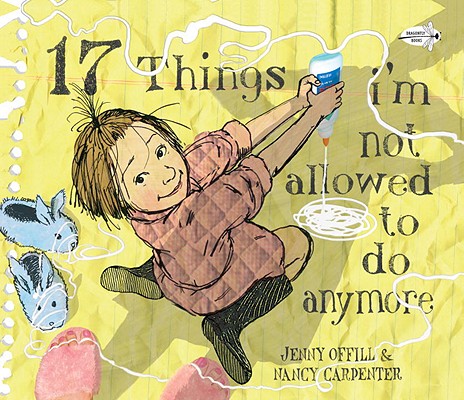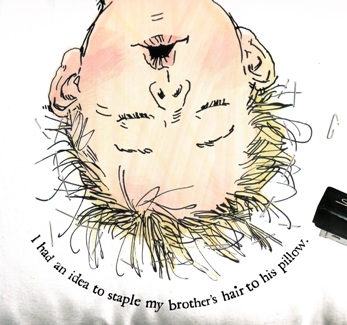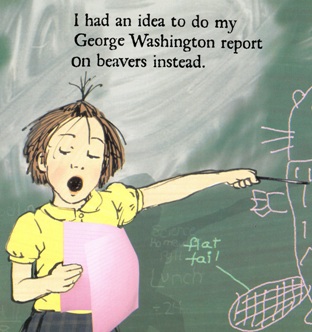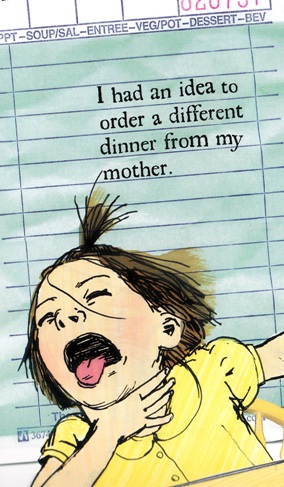The first thing you should know about 17 Things I’m Not Allowed to Do Anymore is that – if a book can make me laugh with its title alone, there’s a 80% chance that I’m either going to buy it or, at the very least, borrow it from the library and keep it until I incur late fees. It might seem immature to be such an easy sell, to be so willing and eager to literally judge a book by its cover, but if an author can make me smirk with something as basic as a book title, that’s an accomplishment I can appreciate. Heck, I believe that the innate power of a killer title is the primary reason why Adam Mansbach’s Go the F**k to Sleep was such a sensation last year. When you encounter a title like that, how can you NOT want to read that book?
And, I’ll admit, it was totally the title that sold me on 17 Things I’m Not Allowed to Do Anymore. I was at the annual American Library Association Conference last year, walked past a table displaying Jenny Offill and Nancy Carpenter’s picture books, and the featured titles alone caused me to stop in my tracks and turn around. (The pair has another book, 11 Experiments That Failed, that also sold me on its title alone.)
As the title hints, 17 Things is a very, very funny picture book, which falls decidedly into the “Kids Behaving Badly” genre of children’s books. Well, “behaving badly” might be a little harsh, but the protagonist of 17 Things I’m Not Allowed to Do Anymore is definitely a grade-A hellraiser. She’s precocious, stubborn, obstinate, and extremely self-possessed. And I think that’s a wonderful thing to see in a kid’s book.
Our unnamed narrator walks us through the “17 things” she’s no longer allowed to do anymore and, as we learn more about her past offenses and the related fallout, personally, I think it’s hard not to fall in love with her. Her list of “things” starts out slow:
I had an idea to staple my brother’s hair to his pillow.
I am not allowed to use the stapler anymore.
It’s a hilarious scenario, which is made even funnier by Nancy Carpenter’s pitch-perfect illustrations. I actually think that 17 Things I’m Not Allowed to Do Anymore is one of the most visually striking picture books we own. Carpenter composes wonderfully comic illustrations for the main characters, but she also creates this fantastically tactile world around them by digitally building their environments out of real-life objects. The backgrounds of the page-spreads are sometimes sheets of notebook paper, sometimes a child’s painting, or sometimes pieces of fabric. In the stapler pages, for example, Carpenter inserts real pictures of staplers and staples into the collage-style page-spreads. It’s original and extremely cool. It almost reminds me of a hybrid of Tony Fucile’s illustrations in Bink & Gollie and Lane Smith’s collages in Cowboy and Octopus. (BTW, both of those books are incredbly awesome.)
As 17 Things progresses, we learn more and more about our young narrator and her “ideas” and she really comes into focus as a living, breathing, three-dimensional kid.
I had an idea to do my George Washington report on beavers instead.
I am not allowed to do reports on beavers anymore.
I had an idea to show Joey Whipple my underpants.
I am not allowed to show Joey Whipple my underpants anymore.
I had an idea to give my brother the gift of cauliflower. (Cut to her flinging the vegetable at her brother’s head.)
I am not allowed to give the gift of cauliflower anymore.
Jenny Offill deserves a ton of credit for coming up with some really funny scenarios that legitimately feel like the wacky logic and single-mindedness of a real live child, not some bland kid lit archetype. (There’s a recurring joke about the girl’s obsession with beavers that my daughter thinks is the funniest thing in the world.) I feel like I understand and know this little unnamed girl with a penchant for doing terrible things to her little brother, and my daughter dearly loves having this fairly intimate window into the life of a little girl who seems so much braver and crazier than she is.
Once, when my daughter was going through a particularly stubborn period, I was describing the situation to my primary care doctor and she just laughed and said, “Well, you want a little fight in them, don’t you? You don’t want your kid to be some lame mouth-breather who does everything you say without question, do you?”
And she was dead right. Perfectly mannered children are aberrations, they’re mutants, they go against the natural order. They don’t and shouldn’t exist. Personally, I think it’s important to allow young readers to see children acting like children – which involves them sometimes making bad and obnoxious decisions – without turning every mistake they make into a preachy morality play.
Can you imagine how annoying that would be as an adult? If every single time you made a mistake at the office or at the bank, if someone swooped in to turn it into a “teaching moment” and reinforce that you screwed up? It’d be like the TPS report scene from Office Space stuck on an infinite loop – you’d have no room to breathe. Unfortunately, I think a lot of kid’s literature gets stuck in that mindset of never letting a child make an honest mistake. Yes, morality is important, but every kid’s book doesn’t have to have a moral or a lesson. Sometimes kids can just BE and we can just assume that they got their 30 daily doses of “No! Don’t! Bad! Why?” from someone else.
Spoiler alert – there is no significant comeuppance for the narrator of 17 Things I’m Not Allowed to Do Anymore. She attempts 17 crazy, crazy things and her punishment is essentially that she’s not allowed to try them anymore. And, in the end, she’s not remorseful and she doesn’t learn an important lesson about good behavior. The book ends with her telling her mom that she’s sorry, even though she’s CLEARLY lying, a situation that 99% of the world’s children are familiar with. She just goes on – being a kid and trying the insane kinds of things that children try every day. And I think that’s wonderful.
Now, regarding the politics of portraying misbehaving kids in children’s books – if you read some of the online reviews of 17 Things I’m Not Allowed to Do Anymore, you’ll occasionally stumble onto a few extremely negative takes on the book. Many of these critical reviews are parents or teachers who are just LIVID that the lead character in 17 Things isn’t remorseful, that she allegedly sends a bad message, that she’s mean, unsympathetic, etc. Here’s an excerpt from one particularly negative review on Amazon.
I would never read this to a child. The protagonist is rewarded for being manipulative, destructive, and dishonest. I am horrified that this is being lauded as a best book for kids. This is a book that makes a hero out of a spoiled brat, and instructs a child to lie to enjoy themselves.
That person is entitled to their opinion, but I think they’re missing the point of 17 Things ENTIRELY. There is not an ounce of malice in 17 Things I’m Not Allowed to Do Anymore. It’s just a kid, a crazy, creative kid – perhaps with a few behavioral problems – testing the boundaries of her world in a very funny and extremely kid-like manner. She’s not made out to be spoiled and there is no “instructing kids to lie”. She’s just acting like a kid. (“Not MY kid!” cries out a platoon of self-righteous, proselytizing parents as I roll my eyes as far back into my skull as possible.)
This is a very, very honest book and I don’t think Jenny Offill and Nancy Carpenter have an innate responsibility to instruct their young readers about the finer points of morality. That responsibility lies with the PARENTS of those readers. Parents, as one of your own, I hate making more work for you, but you can’t expect a BOOK to teach your child about right and wrong. A book can be a tool for helping teach morality, but only if parents have laid the foundation themselves first.
When I read 17 Things with my daughter, she marvels at what the narrator is trying to get away with (and laughs her butt off), but she doesn’t need the book to tell her when the narrator is behaving properly and when she isn’t. You know why? Because my wife and I teach her about proper behavior every damn day. And I’m confident enough in my daughter’s ability to judge right from wrong that I can let her read a book where a kid makes some crazy choices without having a panic attack about her trying to emulate everything she sees on the printed page.
Even though she’s exposed to books all the time, my daughter has yet to run off to the Wild Things and start a wild rumpus or make an ill-advised wish on a magic pebble, so I’m not really worried that she might “run away to live with the kind and happy beavers” – another FANTASTIC idea from the narrator of 17 Things – just because a picture book told her to.
17 Things I’m Not Allowed to Do Anymore is a wonderful book about a kid being a kid. It’s funny, it’s authentic, it’s beautiful to look at, it speaks to young readers on a very personal level, and – have I mentioned that it’s funny yet? Leave your reservations at the door and just enjoy watching a kid make some terrible, TERRIBLE decisions. And, trust me, it’s WAY funnier when it’s not your kid.
THE DETAILS ON 17 THINGS I’M NOT ALLOWED TO DO ANYMORE
AGE RANGE: The stated age range is 4 and up and I agree with that. While I disagree with parents keeping this book from their kids because of the bad behavior depicted, I will acknowledge that there are some subtle concepts being presented in 17 Things – particularly the narrator’s rationale for lying to her mother – that might go sailing over the heads of younger kids.
PAGE COUNT: 32 pages
RELATED WEB SITES: I couldn’t find much of a web presence for Jenny Offill or Nancy Carpenter and here’s the disappointingly empty official Random House page for 17 Things.
BUY IT, BORROW IT, OR FORGET IT?: I think this is an original and unique kid’s book, so my instinct is that it’s a really good book to buy, either for yourself or for others. However… you REALLY have to know your audience with this one. If, as a parent, you know you won’t appreciate a possibly unsympathetic lead character or if the lack of a hardcore moral lesson will bug you, avoid it. If you think your kid is actually crazy enough to try something they read in a book, you might want to avoid… but it might actually be pretty funny too.
IF YOU LIKED 17 THINGS I’M NOT ALLOWED TO DO ANYMORE, YOU MIGHT ALSO LIKE:
- The Day I Swapped My Dad for Two Goldfish by Neil Gaiman, illustrated by Dave McKean – This is another great picture book in which a kid creates a delicious cocktail of lovably crazy kid logic to get what he’s after. In this case, our narrator convinces his friend to trade him two goldfish for the narrator’s perpetually newspaper-reading father. It seems like the perfect scenario… until his mom comes home and he has to track down his dad, who has been swapped between several other kids in the meantime. Like Offill, Gaiman does an admirable job of making the book speak to kids on THEIR level – it gets the “voice” of children dead-on right – and, like Carpenter, McKean turns the book into a visual feast, using a variety of techniques to make The Day I Swapped My Dad an extremely memorable reading experience.
- Always Listen to Your Mother by Florence Parry Heide and Roxanne Heide Pierce, illustrated by Kyle M. Stone – A collaboration between one of my favorite kid’s authors of all time and her daughter, Always Listen to Your Mother is a sweet little ode to parents recognizing that their kids don’t always have to be perfect. Ernest is a little boy who ALWAYS listens to his shrill mother – and subsequently never has a good time. One day, Ernest’s mother allows him to go next door to play with his new neighbors, who look like cousins of the Addams Family, and the new lovably monstrous family teaches him the benefits of playing, being wild, and occasionally acting like a kid.




{ 3 comments… read them below or add one }
It’s funny the different things people take away from books. I was utterly depressed and horrified.when I read it. What I saw was in incredibly creative, funny girl who was never guided toward using her creativity and energy in a constructive way. The adults in her life are soul-sucking autocrats who haven’t got a clue how to cope with an inquisitive, independent, creative child. Want to use a stapler? Here, make some art with this tissue paper and a paper bag. How about some credit for the beaver project? I see you are fascinated with beavers – thanks for the info – you did a marvellous job! Let’s see how beavers were an important part of early American commerce in the time of Washington. All she learns at the end of the book is that adult don’t care about her activities as long as she pretends to behave. And if lying is the way to preserve her identity, there you go. I get a knot in my stomach every time I think about this book. It presents the institutionalized suppression of creativity in our kids as funny – but I just want to cry.
Wow. You’re right. We had totally different takes on this book.
But, at the very least, thanks to the sequel, 11 Experiments That Failed, we know that NOTHING is going to suppress that little girl, so… at least there’s that.
Kidding aside, I totally see where you’re coming from, but I just didn’t get that vibe from the book myself. I just saw a kid who was confident and self-possessed at the beginning of the book and she remained that way all the way through the end. The people in her life perhaps didn’t understand her, but that was OK because she was a force of nature. She was true to herself and no amount of outside influence was going to change her. And, to me, it felt like the book wasn’t judging her. It was just allowing her to be. And, who cares if a teacher or if her mother seems exasperated with her? Our sympathies are readers unquestionably lie with that litltle girl.
But that was just my reading of it. I’m wrong ALL THE TIME.
That’s a really interesting point. I didn’t think about it like that either. But at the same time, this book is just limited to the things she’s not allowed to do . . . so to be honest maybe she is guided toward other things, but we don’t see that here. If my daughter stapled anyone’s hair to the pillow, I can assure you she’d lose privileges to the stapler. As for the beaver project, she didn’t follow directions. Now if she wrote about how beavers and Washington somehow worked together as friends to shape our country . . . that would have been hilarious.
I just look at this book as the way kids think and how they test out theories. I don’t think this kid will ever be suppressed and that’s what I love.
But again, totally different take.